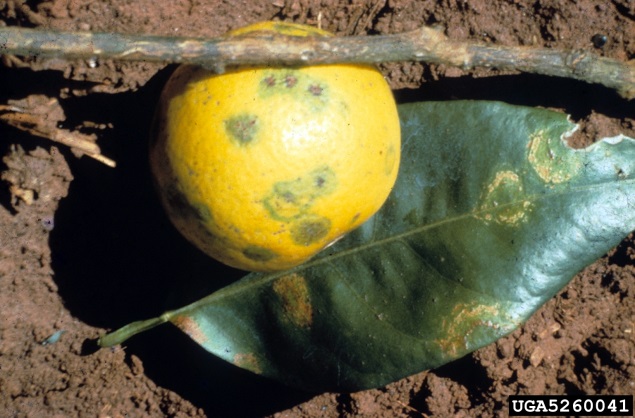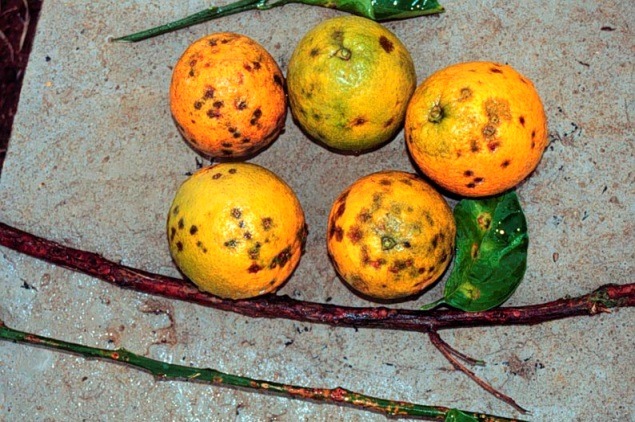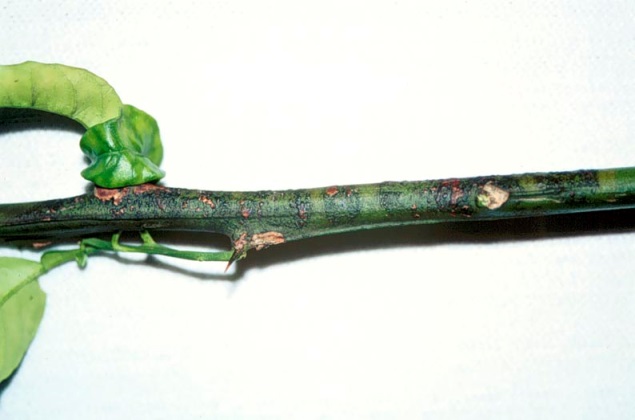
Citrus leprosis virus
| Primefact number | Edition | Published | Author |
|---|---|---|---|
| 1354 | Second | Mar 2019 | Plant Biosecurity and Product Integrity |



Citrus leprosis virus (leprosis) is an exotic plant pest. This disease is a serious threat to Australia’s citrus industry.
Leprosis is a disease of citrus plants. Leprosis is caused by the citrus leprosis virus and is vectored by false spider mites. Leprosis is characterised by localised lesions in leaves, twigs and fruit. The lesions do not expand in size or spread as each lesion is the plants response to the insect vector feeding on it.
Leprosis is a plant disease of citrus and is not harmful to people or animals.
Notifiable status
Citrus leprosis virus is a notifiable plant disease in NSW.
All notifiable plant pests and diseases must be reported within 1 working day. You can report notifiable plant pests and diseases by one of the following methods:
- Call the Exotic Plant Pest Hotline 1800 084 881
- Email biosecurity@dpi.nsw.gov.au with a clear photo and your contact details
- Complete an online form
A full list of notifiable plant pests and diseases can be found in Schedule 2 of the NSW Biosecurity Act 2015.
Description
Localised leprosis lesions are found on fruits, leaves and twigs. The severity of symptoms varies with the type of citrus.
Leaf lesions are usually round, dark brown in colour, 2–3 mm in diameter and surrounded by a chlorotic halo in which one or two brownish rings may appear (Figure 1). The overall lesion size varies from 10–20 mm.
Fruit lesions are round, dark brown dead spots 10–20 mm in diameter on the skin (Figure 2). Occasionally gum may exude from the lesion.
On green unripe fruit the lesions are initially yellow, but become more brown or black over time. Green fruit lesions may appear sunken.
Stem lesions are grey or brown in colour and may be raised above the surface of the stem (Figure 3). Stem lesions may appear to be joined together when vectors are present in large numbers. Death of the twig may occur. In extreme cases severe defoliation and fruit fall may occur.
Leprosis leaf symptoms may be confused with pesticide injury or insect damage. Fruit symptoms may be confused with citrus canker (Xanthomonas citri subsp. citri).
On the trunk of an infected citrus tree, leprosis bark scaling symptoms may appear similar to citrus psorosis virus (bark scaling) which is present in Australia. The psorosis virus causes wood staining while leprosis does not.
Damage
Fruit with leprosis lesions has low commercial value especially for fresh consumption.
Host range
Leprosis primarily affects sweet orange (Citrus sinensis) but has been recorded on other citrus varieties.
Spread
Citrus leprosis virus is vectored by false spider mites in the genus Brevipalpus. False spider mites are found throughout the world including Australia.
All life stages of the mite are able to transmit citrus leprosis virus. Newly hatched mites must feed on infected plant tissue containing viral particles in order to acquire the virus.
Citrus leprosis virus does not move systemically within the host plant. Each lesion is associated with the vector mite feeding on the host plant.
Distribution
Leprosis is reported to occur in Central and South America as well as Hawaii.
Actions to minimise risks
Put in place biosecurity best practice actions to prevent entry, establishment and spread of pests and diseases:
- practice “Come clean, Go clean”
- ensure all staff and visitors are instructed in and adhere to your business management hygiene requirements
- source propagation material of a known high health status from reputable suppliers
- monitor your plants and fruit regularly
- keep records

